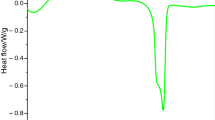Abstract
This paper presents a study on rapid hardening behaviors of β-C2S by accelerated carbonation curing. β-C2S cubes compacted at various molding pressures were subjected to different CO2 concentration for accelerated carbonation curing. The CO2 uptake and microstructure changes were analyzed by thermogravimetric analysis (TG), QXRD, FT-IR and MAS-NMR. The results indicated that CO2 uptake was affected by molding pressure and CO2 concentration seriously. TG analysis indicated that the carbonation reaction was rapid in the first hour. The carbonation degree reached 21.6% and giving a compressive strength of 85.7 MPa after 6 h carbonation in 99.9% CO2 concentration. And it showed a much less carbonation degree in 20.0% CO2. Calcite, vaterite and amorphous silica-rich phase formed in the carbonation progress. The FT-IR and NMR analysis indicated β-C2S was decalcified to C–S–H gel and further decalcified to formation of an amorphous silica gel composed of Q 3 and Q 4 silicate tetrahedral. The chain length of C–S–H gel increased from to 2.67 to 6.36 with prolonged carbonation time, showing a lower C/S ratio and higher polymerization and also resulting in a lower C–S–H content.










Similar content being viewed by others
References
Gregg JS, Andres RJ, Marland G. China: emissions pattern of the world leader in CO2 emissions from fossil fuel consumption and cement production. Geophys Res Lett. 2008;35(8):L08806.
Mabudo GM, Lee S, Kang S, et al. Physical properties and carbon dioxide capture of synthetic gamma-C2S cement composites in the early days of curing. Mag Concr Res. 2016;68(21):1079–84.
Carrasco-Maldonado F, Spörl R, Fleiger K, et al. Oxy-fuel combustion technology for cement production—state of the art research and technology development. Int J Greenh Gas Control. 2016;45:189–99.
Maheswaran S, Kalaiselvam S, Saravana Karthikeyan SKS, et al. β-Belite cements (β-dicalcium silicate) obtained from calcined lime sludge and silica fume. Cem Concr Compos. 2016;66:57–65.
Gong Y, Fang Y. Preparation of belite cement from stockpiled high-carbon fly ash using granule-hydrothermal synthesis method. Constr Build Mater. 2016;111:175–81.
Staněk T, Sulovský P. Active low-energy belite cement. Cem Concr Res. 2015;68:203–10.
Kacimi L, Simon-Masseron A, Salem S, et al. Synthesis of belite cement clinker of high hydraulic reactivity. Cem Concr Res. 2009;39(7):559–65.
Campillo I, Guerrero A, Dolado JS, et al. Improvement of initial mechanical strength by nanoalumina in belite cements. Mater Lett. 2007;61(8):1889–92.
Bodor M, Santos RM, Kriskova L, et al. Susceptibility of mineral phases of steel slags towards carbonation: mineralogical, morphological and chemical assessment. Eur J Minneral. 2013;25(4):533–49.
Morandeau A, Thiéry M, Dangla P. Impact of accelerated carbonation on OPC cement paste blended with fly ash. Cem Concr Res. 2015;67:226–36.
Jang JG, Lee HK. Microstructural densification and CO2 uptake promoted by the carbonation curing of belite-rich Portland cement. Cem Concr Res. 2016;82:50–7.
Ghouleh Z, Guthrie RIL, Shao Y. High-strength KOBM steel slag binder activated by carbonation. Constr Build Mater. 2015;99:175–83.
Šavija B, Luković M. Carbonation of cement paste: understanding, challenges, and opportunities. Constr Build Mater. 2016;117:285–301.
Ashraf W. Carbonation of cement-based materials: challenges and opportunities. Constr Build Mater. 2016;120:558–70.
Bertos MF, Simons S, Hills CD, et al. A review of accelerated carbonation technology in the treatment of cement-based materials and sequestration of CO2. J Hazard Mater. 2004;112(3):193–205.
Shao Y, Mirza MS, Wu X. CO2 sequestration using calcium-silicate concrete. Can J Civil Eng. 2006;33(6):776–84.
Chang J, Li Y, Cao M, et al. Influence of magnesium hydroxide content and fineness on the carbonation of calcium hydroxide. Constr Build Mater. 2014;55:82–8.
Rostami V, Shao Y, Boyd AJ, et al. Microstructure of cement paste subject to early carbonation curing. Cem Concr Res. 2012;42(1):186–93.
Huijgen WJ, Witkamp G, Comans RN. Mineral CO2 sequestration by steel slag carbonation. Environ Sci Technol. 2005;39(24):9676–82.
Mo L, Panesar DK. Effects of accelerated carbonation on the microstructure of Portland cement pastes containing reactive MgO. Cem Concr Res. 2012;42(6):769–77.
García-Lodeiro I, Fernández-Jiménez A, Blanco MT, et al. FTIR study of the sol–gel synthesis of cementitious gels: C–S–H and N–A–S–H. J Sol-Gel Sci Technol. 2008;45(1):63–72.
Ashraf W, Olek J. Carbonation behavior of hydraulic and non-hydraulic calcium silicates: potential of utilizing low-lime calcium silicates in cement-based materials. J Mater Sci. 2016;51(13):6173–91.
Mollah M, Yu W, Schennach R, et al. A Fourier transform infrared spectroscopic investigation of the early hydration of Portland cement and the influence of sodium lignosulfonate. Cem Concr Res. 2000;30(2):267–73.
Lodeiro IG, Fernández-Jimenez A, Palomo A, et al. Effect on fresh CSH gels of the simultaneous addition of alkali and aluminium. Cem Concr Res. 2010;40(1):27–32.
Puertas F, Palacios M, Manzano H, et al. A model for the CASH gel formed in alkali-activated slag cements. J Eur Ceram Soc. 2011;31(12):2043–56.
Pérez G, Guerrero A, Gaitero JJ, et al. Structural characterization of C–S–H gel through an improved deconvolution analysis of NMR spectra. J Mater Sci. 2014;49(1):142–52.
Sevelsted TF, Skibsted J. Carbonation of C–S–H and C–A–S–H samples studied by 13C, 27Al and 29Si MAS NMR spectroscopy. Cem Concr Res. 2015;71:56–65.
Acknowledgements
This work was financed by National Natural Science Foundation of China (51172096) and Equipment Open Sharing Test Fund of Dalian University of Technology.
Author information
Authors and Affiliations
Corresponding author
Rights and permissions
About this article
Cite this article
Fang, Y., Chang, J. Rapid hardening β-C2S mineral and microstructure changes activated by accelerated carbonation curing. J Therm Anal Calorim 129, 681–689 (2017). https://doi.org/10.1007/s10973-017-6165-z
Received:
Accepted:
Published:
Issue Date:
DOI: https://doi.org/10.1007/s10973-017-6165-z




